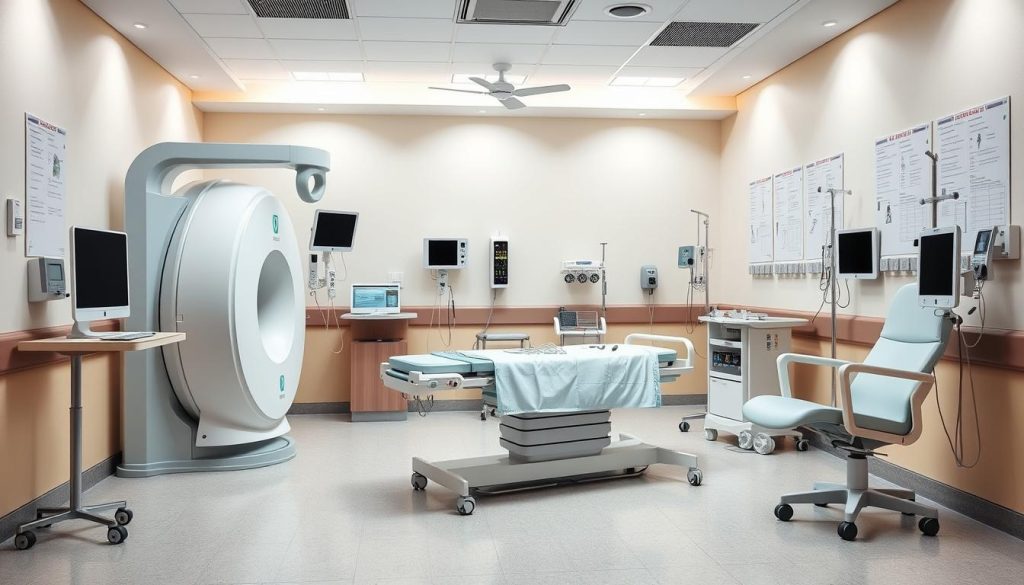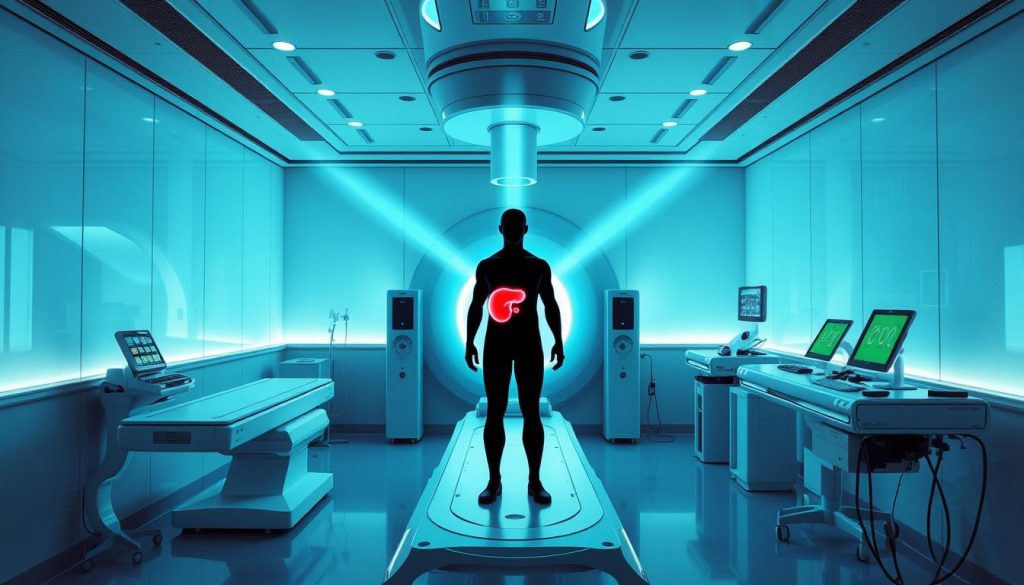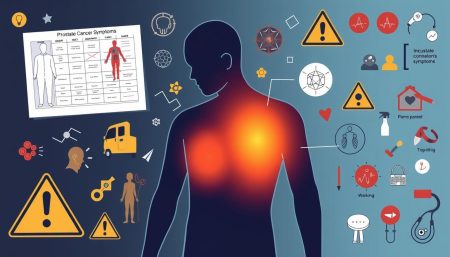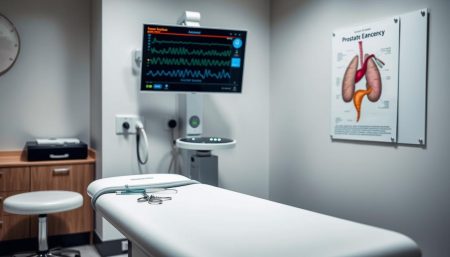Getting a prostate cancer diagnosis can feel scary. But, there’s good news: many treatment options are available today. Doctors work with patients to make a treatment plan that fits their needs.
This guide will look at different ways to treat prostate cancer. We’ll see how doctors make treatments fit each patient’s needs. We want to give you clear, caring information to help you through this tough time.
Knowing how to treat prostate cancer is key for patients and their families. We want to give you the knowledge and confidence to make good choices about your care. We aim to bring hope and strength to you during treatment.
Understanding Prostate Cancer Diagnosis and Staging
Diagnosing prostate cancer is a key step in finding the right treatment. It involves several stages, from first screening to detailed risk checks. Doctors use these steps to create effective treatment plans.
Initial Screening and Detection Methods
Prostate cancer screening starts with two main tests:
- PSA (Prostate-Specific Antigen) blood test
- Digital rectal exam (DRE)
If these tests show possible issues, doctors might suggest more tests. These could be prostate biopsies or imaging studies. Early detection is crucial for effective treatment planning.
Gleason Score and Cancer Staging
The Gleason score shows how aggressive prostate cancer is. It’s based on cancer cell appearance under a microscope. A higher score means more aggressive cancer, affecting treatment choices.
Risk Assessment and Treatment Planning
Doctors consider several factors for risk assessment and treatment planning:
- PSA levels
- Gleason score
- Cancer stage
- Overall health
This detailed evaluation helps pick the best treatment. From active surveillance for low-risk cases to aggressive treatments for advanced stages, knowing your diagnosis is essential. It helps make informed decisions about treatment.
How Do You Treat Prostate Cancer: A Comprehensive Overview
Prostate cancer treatment depends on the cancer’s stage, how aggressive it is, and the patient’s health. When you ask “how do you treat prostate cancer,” remember there’s no single answer. Each case is different.

- Surgery (radical prostatectomy)
- Radiation therapy
- Hormone therapy
- Chemotherapy
- Immunotherapy
- Targeted therapy
Surgery and radiation therapy are common for early prostate cancer. They aim to remove or kill cancer cells in the prostate. For more advanced cases, hormone therapy might be suggested to slow the cancer’s growth.
Choosing the right treatment means looking at the good and bad sides. Some men choose active surveillance, which means watching the cancer closely without immediate treatment. This is best for slow-growing, low-risk cancers.
“The goal is to tailor treatment to each patient’s unique situation, maximizing effectiveness while minimizing side effects.”
New treatments like immunotherapy and targeted therapy offer hope for advanced cases. These methods use the body’s immune system or target specific cancer molecules.
Your healthcare team will help you decide, considering your age, health, and what you prefer. Remember, prostate cancer treatment is always changing. New research brings new options to help patients.
Surgical Treatment Options for Prostate Cancer
Surgery is a key way to treat prostate cancer. The main surgery for prostate cancer is called radical prostatectomy. This involves removing the whole prostate gland. It aims to get rid of cancer cells and stop them from spreading.
Radical Prostatectomy Procedures
There are different ways to do radical prostatectomy:
- Open surgery: A big cut in the lower belly
- Laparoscopic surgery: Small cuts for a camera and tools
- Robotic-assisted surgery: Uses advanced tech for better precision
Robotic-Assisted Surgery Benefits
Robotic-assisted prostatectomy has many good points:
| Benefit | Description |
|---|---|
| Precision | It uses 3D views and steady hands for better results |
| Less Blood Loss | It makes smaller cuts, which means less bleeding |
| Faster Recovery | Patients can go home sooner |
Post-Surgery Recovery and Care
Recovering from prostate cancer surgery takes time and care. Patients usually stay in the hospital for 1-2 days. At home, they need to:
- Manage pain with the right meds
- Start moving more slowly
- Look after the catheter (usually out after 1-2 weeks)
- Go to check-ups to see how they’re healing
Knowing about these surgery options helps patients make better choices. Each method has its own pros and cons. It’s important to talk about these with a doctor.
“Surgical intervention for prostate cancer is a big step. Patients should ask lots of questions and understand their treatment plan well.”
Radiation Therapy Approaches in Prostate Cancer Treatment
Radiation therapy is a strong option for treating prostate cancer. It uses high-energy rays to kill cancer cells. This method is often chosen when deciding how to treat prostate cancer.

External Beam Radiation Therapy (EBRT)
EBRT is a common form of radiation therapy. It sends radiation from outside the body. Treatments are usually given five days a week for several weeks.
New techniques like IMRT and IGRT make EBRT more precise. This reduces side effects.
Brachytherapy Options and Applications
Brachytherapy involves placing radioactive seeds directly into the prostate. This method allows for a higher dose of radiation. It causes less damage to surrounding tissues.
It can be done as a single procedure or in multiple sessions.
Managing Radiation Side Effects
Radiation therapy can cause side effects like urinary problems and fatigue. These effects are usually temporary. Your care team will work with you to manage any discomfort.
They may recommend diet changes, medication, or exercises to help.
“Radiation therapy has come a long way. We now have tools to target cancer cells more precisely while sparing healthy tissue.”
Choosing the right radiation approach depends on your specific case. Your doctor will consider factors like cancer stage, overall health, and personal preferences. They will recommend a treatment plan based on these factors.
Hormone Therapy and Systemic Treatments
Hormone therapy for prostate cancer targets male hormones that help cancer grow. It lowers testosterone levels or blocks its effects on cancer cells. Doctors often suggest hormone therapy for advanced prostate cancer or when it spreads beyond the prostate.
- Luteinizing hormone-releasing hormone (LHRH) agonists
- LHRH antagonists
- Anti-androgens
- Abiraterone
Each type works differently to reduce testosterone levels or block its effects. Side effects may include hot flashes, weight gain, and loss of muscle mass. Your doctor will help you weigh the benefits against potential side effects.
When hormone therapy becomes less effective, chemotherapy for prostate cancer may be the next step. This treatment uses drugs to kill cancer cells throughout the body. Common chemotherapy drugs for prostate cancer include docetaxel and cabazitaxel.
“Chemotherapy can be a powerful tool in fighting advanced prostate cancer, but it comes with its own set of challenges. We work closely with patients to manage side effects and maintain quality of life.”
The choice between hormone therapy and chemotherapy depends on various factors. These include cancer stage, overall health, and treatment goals. Your oncologist will create a personalized treatment plan based on your specific situation.
| Treatment | Primary Use | Common Side Effects |
|---|---|---|
| Hormone Therapy | Advanced or metastatic prostate cancer | Hot flashes, erectile dysfunction, bone loss |
| Chemotherapy | Hormone-resistant prostate cancer | Fatigue, nausea, hair loss, increased infection risk |
Advanced Treatment Options: Immunotherapy and Targeted Therapies
New ways to fight prostate cancer are being found. These new treatments give hope to those looking for different options. Let’s look at some of these new methods.
Immunotherapy Breakthrough Treatments
Immunotherapy for prostate cancer is very promising. It helps your body fight cancer cells better. Some people have seen tumors shrink or even disappear.
Precision Medicine Approaches
Precision medicine treats each patient based on their genes. Doctors use DNA analysis to pick the best treatments. This approach aims to make treatments more effective and safer.
Clinical Trial Opportunities
Clinical trials are key in improving prostate cancer care. They test new treatments and offer patients access to the latest therapies. For those looking for new ways to treat prostate cancer, trials might be the answer. They help find better treatments for the future.
FAQ
Q: What are the main treatment options for prostate cancer?
A: Treatments for prostate cancer include surgery, radiation, hormone therapy, and chemotherapy. Immunotherapy and active surveillance are also options. The right treatment depends on the cancer’s stage, Gleason score, and the patient’s health.
Q: How is prostate cancer initially diagnosed?
A: Doctors use PSA tests, digital rectal exams, and biopsies to find prostate cancer. These tests check for cancer and how aggressive it might be.
Q: What is a Gleason score and why is it important?
A: The Gleason score shows how aggressive prostate cancer is. It ranges from 6 to 10. A higher score means the cancer is more aggressive. This score helps doctors choose the best treatment.
Q: What are the advantages of robotic-assisted prostate surgery?
A: Robotic-assisted surgery has many benefits. It uses smaller incisions and causes less pain. Patients often recover faster and have less blood loss. It also helps preserve urinary and sexual function.
Q: What’s the difference between external beam radiation therapy and brachytherapy?
A: External beam radiation uses beams from outside the body. Brachytherapy places radioactive seeds inside the prostate. Brachytherapy is often quicker, but the choice depends on the cancer’s stage and the patient’s preferences.
Q: How does hormone therapy work in treating prostate cancer?
A: Hormone therapy reduces male hormones that can make cancer grow. It can be through medication or surgery. It’s used in advanced cases or with other treatments.
Q: What is immunotherapy, and how is it used in prostate cancer treatment?
A: Immunotherapy uses the body’s immune system to fight cancer. In prostate cancer, treatments like Sipuleucel-T target cancer cells. It’s mainly used in advanced cases, but research is ongoing.
Q: What is active surveillance, and when is it recommended?
A: Active surveillance means watching the cancer closely without immediate treatment. It’s for men with low-risk, slow-growing cancer. It helps avoid treatment side effects while monitoring the cancer.
Q: Are there any new treatments being developed for prostate cancer?
A: Yes, new treatments are being developed. These include advanced immunotherapy and targeted therapies. They’re available in clinical trials.
Q: How do doctors decide which treatment is best for each patient?
A: Doctors consider many factors when choosing treatment. These include the cancer’s stage, PSA levels, and the patient’s health. They aim to find the best treatment while considering quality of life.


















